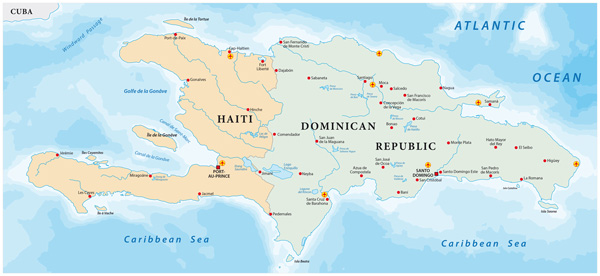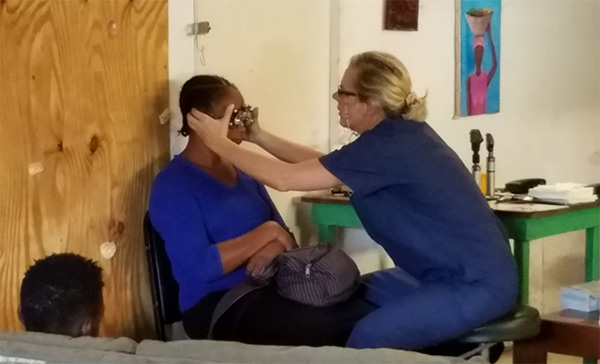By Barbara Fluder, OD, of Merrillville, Indiana
If you have never been on a mission trip, you don’t know how humbling and rewarding it can be. My first mission trip was to the Dominican Republic in 2012. I would like to share my November 2016 trip to Haiti with you.
My journey began when I started talking to our refractive coordinator at our office. I mentioned I wanted to do another mission trip. She put me in contact with Dr. Dennis Cowley, an Indiana native, who moved to Haiti and works at the Baptist Haiti Mission. I successfully recruited my husband, who is an excellent trip coordinator and optician. It’s best to start early in the planning process and our trip took over one year to plan. Trying to rush a mission trip only leads to frustration and detracts from the enjoyment of the mission.


Consider protections
Things to consider on a mission trip include local health conditions as well as political and safety concerns. We had to consider vaccinations and medications for malaria, cholera, typhoid and hepatitis A. Fortunately, we both came home healthy. There were political concerns. The October hurricane in Haiti had postponed the presidential election to the day we were flying in. We registered our trip with STEP (Smart Traveler Enrollment Program). The U.S. Embassy emailed updates regarding any unrest such as riots, roadblocks or violence. I found this a blessing and a curse. While I appreciate the concern for my safety, embassy representatives informed me that if I chose to fly on election day, they would not be available to come help me if I ran into trouble. Although the Embassy was on lockdown that day, I still recommend registering with them when you travel internationally.
The packing list
It is important to have a contact person with whom to communicate while planning your trip. This individual is key to informing you what equipment you need, the facility at which you will be working, and the environment as well. Inquire as to the lighting conditions and access to electricity. This is important when you are trying to perform retinoscopy on older individuals with small pupils or cataracts. If the lighting is poor I know to bring my retinoscope with the brightest beam. I know if I’m not in a clinic setting, I will need to bring portable chargers for the equipment as well as a Perkins tonometer and portable slit lamp and ophthalmoscope. Bringing a binocular indirect ophthalmoscope is great if you have access to electricity but can be difficult to pack. It is good to know the temperature and weather conditions as well.
Usually, there is limited space for luggage so being able to pack light with personal items is critical. We were instructed to wear scrubs all week, which made packing easy. Find out what your living conditions and dining options are, as well. We knew we would be on our own for breakfast and lunch so we packed protein bars and simple snacks. We had limited electricity from the grid but had battery backup. We had relatively hot water but limited water pressure. Be sure to ask if sheets and towels are provided. Most organizations are very appreciative to have your services for a week and will make acceptable accommodations for you. We had a small apartment at the mission designated for volunteers.


Gauge the ocular demographics
Before we arrived in Haiti, we purchased and shipped 1600 pairs of sunglasses and 600 pairs of reading glasses. It’s a good idea if you can find out what the ocular demographics are before you arrive. For example, we knew when we went to both the Dominican Republic and Haiti that most individuals are hyperopic and presbyopic.
I packed the following equipment with me: retinoscope, ophthalmoscope, extra handles, charger, penlight, batteries, ret bar, +1.50 glasses (to take out my working distance), Perkins tonometer and fluorescein. The optometrist there provided trial frame and lenses, alcohol wipes, tissues, tickets for patients, visual acuity chart, clip boards, prescription drops and artificial tears.
Organize the flow
It is desirable that your contact person arrange a system to see patients in an organized and orderly fashion. Our trip to Haiti involved giving out tickets every morning to those in line. If they did not have a ticket that day, they were told to come back the next day. This can get a little challenging on the last day. Once word gets out that you are in town, everyone shows up. We gave out the last tickets on Friday and had to have a security guard present to disperse the remaining crowd. Keep in mind that it is impossible to see everyone in one week. We set up our clinic in a large hall. If possible, set up the evening before you start so you are ready to go the next morning. It’s good to get everyone involved to meet the day before so everyone knows how the patients will flow and everyone knows their job. We had three translators, two doctors, one optician, two people checking visual acuities, and one person at the registration table.
Each work day began around 8:30 a.m. Since the clinic is associated with Baptist Haiti Mission, every morning started with devotions for a half hour before opening. We worked until around noon and took a one hour break. We worked until about 4:30 p.m.
I have noticed it takes me an hour or so to get in my groove regarding patient flow and rearranging my equipment to suit my needs. I find having a stool on wheels is key to move around quickly and control lower back pain, which comes with mission trips.
Uncommon conditions
We started on a Monday morning and hit the ground running. One of my first patients of the day had a complete third nerve palsy involving the pupil. She said she had it for 22 days. She had no vision in the eye and her pressure was somewhat elevated. Most concerning was the pain she was in. I quickly discovered that there are no MRIs in Haiti. They can do CT scans. I was able to have the local physician see her and confirm the diagnosis and assist in getting the test ordered. It is most frustrating that things don’t move with the speed that we are accustomed to in the U.S. My two primary differential diagnoses were a space occupying lesion or aneurysm. I gave the local physician my email address to keep me updated after I left but have not heard anything.
Following her, I saw a gentleman with a foreign body in his eye for five months. Luckily, it was a nonmetallic foreign body located at the limbus, so he was able to tolerate it this long. I had to take him to the actual eye clinic and use the slit lamp and TB needle to remove it. It was removed without incident, and he was very grateful. I should add that the eye clinic is a very small office with limited space, and, therefore, we had to do the exams in a hall because there simply was no room for the volume of people we were seeing.
We diagnosed and treated numerous patients with glaucoma. Luckily, the optometrist at the clinic has a large supply of glaucoma meds. He is able to dispense them free of charge for those in need. Patients in Haiti understand what glaucoma is because a number of them have family members who have gone blind without treatment. They understand the importance of diagnosis and treatment in order to maintain sight to keep their jobs and provide for their families. Steady jobs are rare in Haiti, and if a patient has a good job, he or she will do anything to keep it.
We traveled one day to a remote clinic in Greffin. It took us about 45 minutes to get there and the journey in a pickup truck was very difficult as the road conditions are very poor. We saw 80 people that day. I examined a one-week-old infant with a mucopurulent discharge. I suspected it was gonorrhea ophthalmia neonatorum. We were able to provide the baby with Vigamox. Even though Vigamox is not recommended for infants under one year, the benefits outweigh the risks in this case. The patient lives in a very remote area and has no access to health care.
Patients’ gratitude
The people you will examine are like no other. They are very simple people getting by in a third world country. They are kind, quiet, and very appreciative for any help you can offer.


Many Haitians have red, irritated, itchy and tearing eyes due to wind, heat, allergies and dryness. I dispensed countless bottles of artificial tears and allergy drops and wished I had brought more with me. I also saw a considerable number of patients with pterygium as well as glaucoma and cataracts. There is limited access to surgical ophthalmologists. Not many ophthalmologists in Haiti are doing surgery. I believe this to be due to both training and access to facilities and equipment.
I had an enormous amount of anxiety about a week before the trip due to the political unrest. I vowed to reconsider doing any future mission trips. Halfway through the week, I was thinking about when I could come back and help out again. A mission trip helps those who would never otherwise receive eyecare, but also helps us to be more grounded as to what is really important in life. I remind myself of this when I feel frustrated with first-world problems, such as my phone not charging or my laptop not rebooting.
If you have ever thought about volunteering on a mission trip, stop thinking about it and set aside time and money to do it. Ask a colleague to join you. Volunteer Optometric Services to Humanity (VOSH) is always looking for volunteers. Many local churches have mission trips, and they may be able to guide you in your quest. Pack your equipment and leave your blow dryer, makeup and dress clothes at home and get out there to save world vision.



